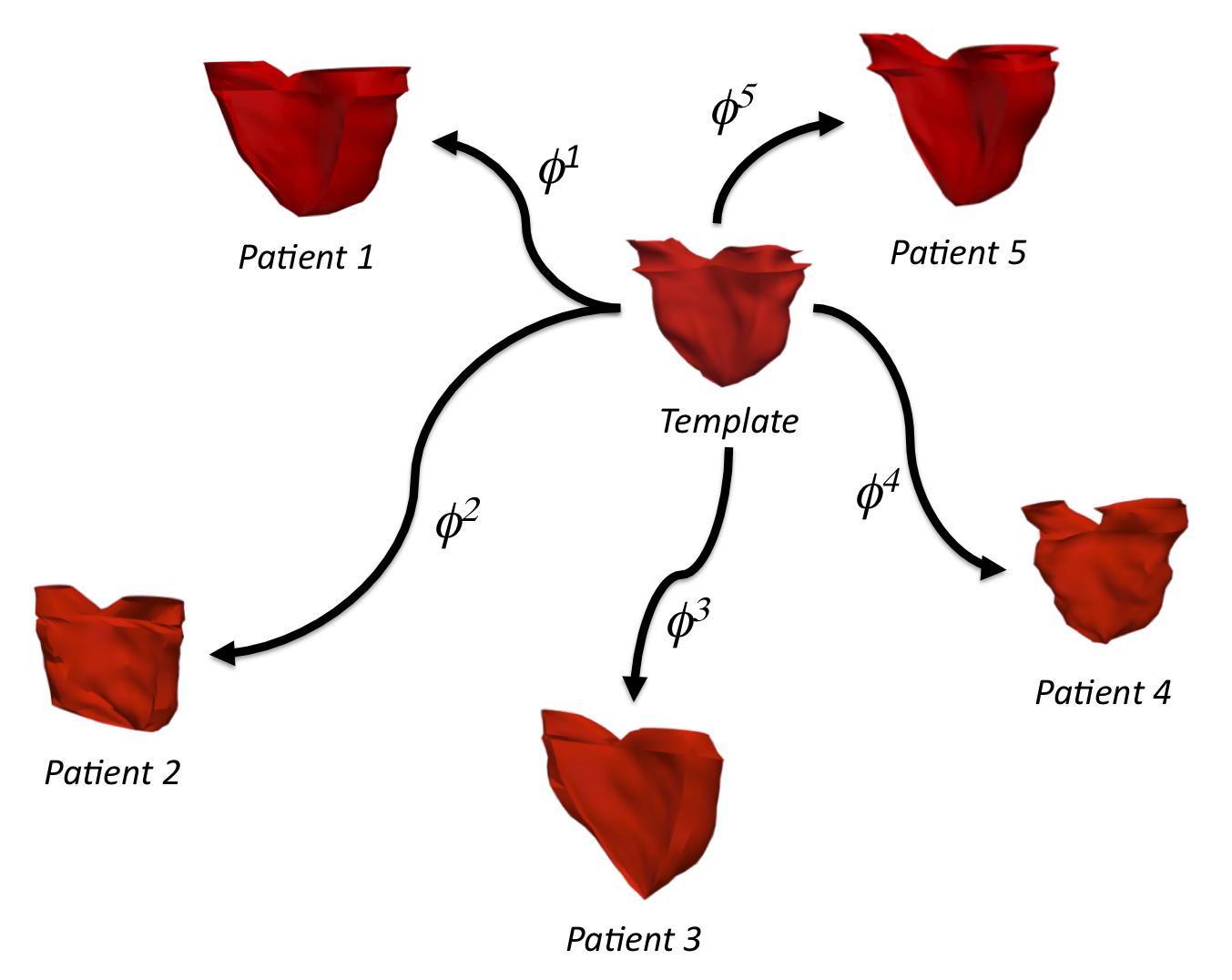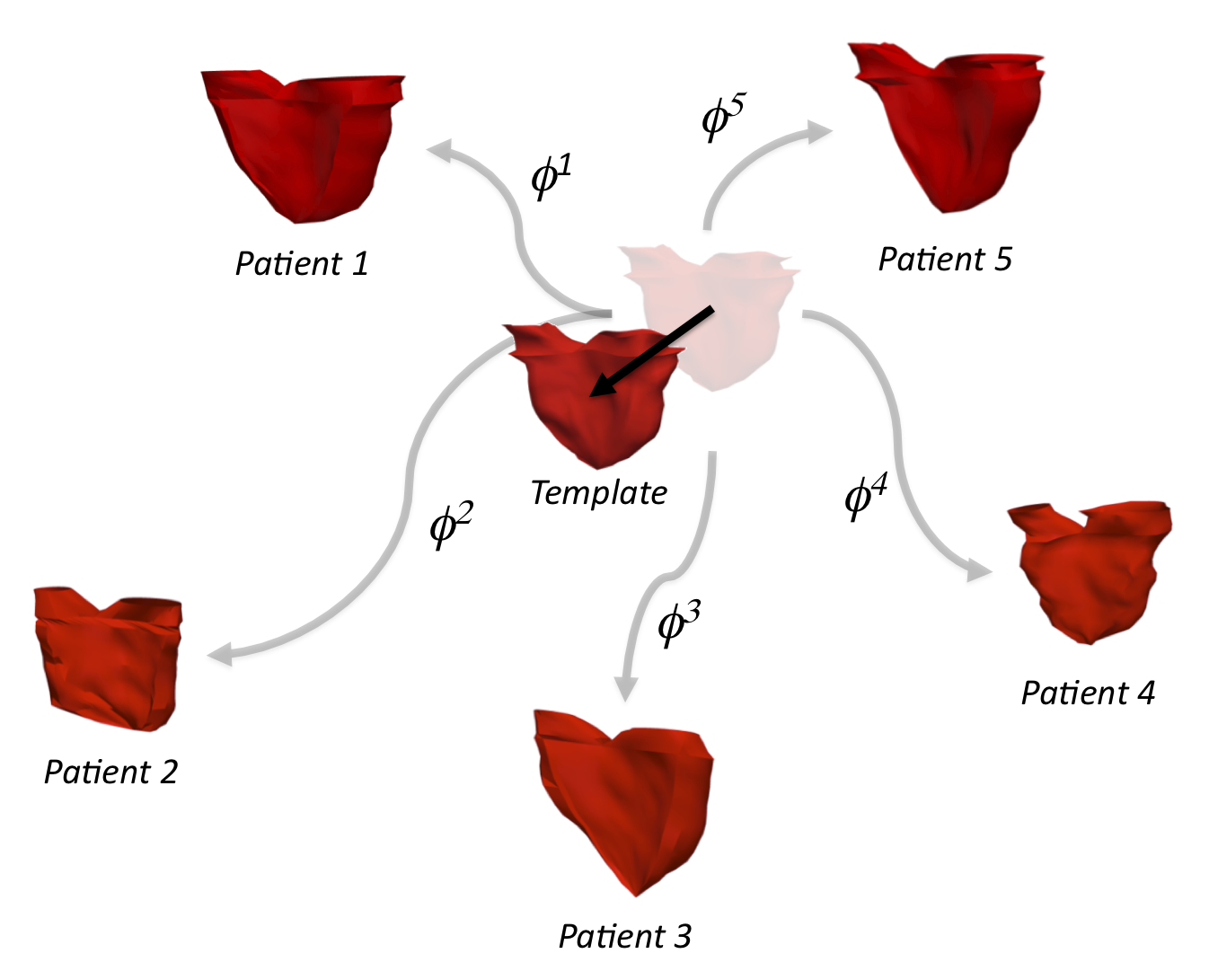Atlas construction
The template  and the deformations ϕi are estimated jointly and consistently by means
of an alternate two-step strategy. The idea is to consider the forward model as a
Bayesian problem where the shapes
and the deformations ϕi are estimated jointly and consistently by means
of an alternate two-step strategy. The idea is to consider the forward model as a
Bayesian problem where the shapes  i are the observations, the template
i are the observations, the template  is the
unknown, the transformations ϕi that register
is the
unknown, the transformations ϕi that register  to the observations are hidden
variables and the residuals ϵi are random Gaussian represented by currents. To find
to the observations are hidden
variables and the residuals ϵi are random Gaussian represented by currents. To find
 and the ϕi simultaneously, the problem is approximated by the minimisation
problem:
and the ϕi simultaneously, the problem is approximated by the minimisation
problem:
 | (1) |
where τ is weights the geodesic regularisation and  0i is the initial velocity field that
parameterises the transformation ϕ. This minimisation problem is very similar to the
registration energy. The first term is the distance between two currents, the transformed
template ϕ*i
0i is the initial velocity field that
parameterises the transformation ϕ. This minimisation problem is very similar to the
registration energy. The first term is the distance between two currents, the transformed
template ϕ*i and the target subject
and the target subject  i. The second term is the geodesic regularisation,
applied to all the transformations to estimate.
i. The second term is the geodesic regularisation,
applied to all the transformations to estimate.
[1] proposed an alternate minimisation of that energy. Assume the template  known, minimising (1) with respect to the ϕi’s amount to registering the present
estimate of the template
known, minimising (1) with respect to the ϕi’s amount to registering the present
estimate of the template  to each patient independently. Once the ϕi’s are found, (1)
is minimised with respect to the template
to each patient independently. Once the ϕi’s are found, (1)
is minimised with respect to the template  . This is achieved using a gradient
descent method, see [1] for details. Intuitively, this step updates the template from the
transformations ϕi to reduce the overall registration error. The new template minimises
the registration errors for all the patient at the same time, i.e. it is more centred
with respect to the population. The algorithm is initialised with the mean current
of all the observations and it is iterated until convergence (Figure 1). In all our
experiments, we fixed τ = 10-3 and adjusted the more intuitive kernel sizes λV 2 and λW 2.
. This is achieved using a gradient
descent method, see [1] for details. Intuitively, this step updates the template from the
transformations ϕi to reduce the overall registration error. The new template minimises
the registration errors for all the patient at the same time, i.e. it is more centred
with respect to the population. The algorithm is initialised with the mean current
of all the observations and it is iterated until convergence (Figure 1). In all our
experiments, we fixed τ = 10-3 and adjusted the more intuitive kernel sizes λV 2 and λW 2.
| A- Estimate the Transformations ϕi | B- Centre the Template |
 |  |
A parallel implementation of the algorithm has been developed to process large amounts
of subjects on clusters of computers. A scheduler script controls the execution of the
algorithm. It dispatches the template-to-patient registrations to all the available computers as
these steps are independent from each other (Figure 1, Step A). It then waits for the
computers to perform the registrations, after what it centres the template (Figure 1, Step B)
and loop until convergence. As a result, the computation time required to estimate the
template minimally depends on the number of subjects.
References
[1] S. Durrleman, X. Pennec, A. Trouvé, and N. Ayache, “Statistical models on sets of curves and surfaces based on currents,” Medical Image Analysis, vol. 13, pp. 793–808, Oct. 2009.